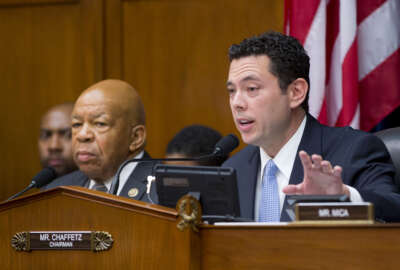
Federal employee groups encourage elimination of Postal Service pre-funding requirement
The most recent plan to save the Postal Service involves taking a page out of the private sector’s book: required enrollment in Medicare.
The very thing designed to keep postal workers and retirees healthy is killing the Postal Service financially. The most recent plan to save it involves taking a page out of the private sector’s book: required enrollment in Medicare.
“The plan is not to pull out of [the Federal Employees Health Benefits Program], but to sort of segment FEHBP. It would be essentially a postal FEHBP,” Jim Sauber, chief of staff of the National Association of Letter Carriers, said during Federal News Radio’s U.S. Postal Service and Its Future month.
The problem is that ever since 2006, the Postal Service has had to pre-fund retiree health benefits, much like a pension. Initially, the requirement only called for it to pre-fund 10 years in advance, but that limit was soon raised to 40 years.
“And that’s not something that’s required of private companies or other agencies,” Sauber told Senior Correspondent Mike Causey. “It’s entirely unique to the Postal Service, and it basically accounts for about 90 percent of the Postal Service’s reported losses since 2007. It’s a burden the Postal Service really can’t afford.”
The initial proposal came from the Government Accountability Office, suggesting the policy should be implemented governmentwide, but it was rejected. It came up again during discussions of postal reform in 2005-06, and got added into the bill due to scoring, Sauber said.
But repealing it didn’t make sense, and other plans to remove the pre-funding requirement fell through, never even receiving a vote in the House of Representatives despite widespread support.
But Jessica Klement, legislative director of the National Active and Retired Federal Employees Association, said that fears of a possible taxpayer bailout of the Postal Service are driving reform talks.
“This mandate to enroll in Medicare parts A, B and D would allow that liability to be so reduced that it almost doesn’t exist anymore,” she said.
Sauber said that required enrollment into Medicare at age 65 is standard in the private sector, and reduces future health care costs to the point of nearly eliminating the cost of pre-funding.
“Because when you have both … Medicare pays first, your FEHBP plan pays second,” Klement said.
“Most people have both. I think it’s upwards of 80 percent of the FEHBP population that’s over the age of 65 has both.”
In fact, she said it’s the question NARFE fields from its members most often: whether or not to take Medicare Part B. And most of the time, NARFE says yes. But there is one problem it sees with requiring everyone to enroll in it.
“What NARFE objects to in the context of these bills is the mandate to take Part B for current retirees and their spouses,” Klement said. “You’re changing the rules of the game; you’re adding an additional health care benefit that these people did not plan for when they retired.”
Although the cost of Medicare enrollment is something most retirees did not budget for, Medicare’s late enrollment fees would be waived, which Klement said is helpful.
“We believe, as an association, that if you gave people the option to do this, you waive the late enrollment fees, most would opt in,” she said.
NALC’s position, Sauber said, is similar.
“We support this idea conceptually,” he said. “It’s going to be a way to solve a thorny problem, the pre-funding problem. In general, we think it’s in our members’ best interests to enroll in Medicare Part B.”
There are a few reasons, however, that NALC has not yet officially endorsed the bill. First, NALC wants to maximize enrollment in Medicare. Second, it wants to see a hardship exemption for those who can’t afford the added cost.
He did say, however, that it might not mean added cost overall.
“Premiums for FEHBP plans covering postal employees would actually go down on a net basis because of saving s from Medicare integration and from getting access to low-cost drugs through the Medicare modernization act and other reforms included in this would drive premiums down,” Sauber said.
But Klement noted that federal employees are a very risk-averse population — many pass up the opportunities to change their health plans, even when they’re likely overpaying for insurance. Because of this, she said automatic enrollment may be the best way to go.
“Given the nature of the federal community, given the decisions they’ve made up until this point, we feel that if you automatically enroll them in Medicare, as the House bill does … and allow them a very short window to opt out — hardship or otherwise; maybe they have an HMO that covers their costs, Medicare would just be an additional cost with very little benefit — give them this short time period to opt out, we believe very few would do so,” she said.
Sauber said that when making decisions like these, the federal government often suffers from unfair comparisons when viewed alongside the private sector.
“You’ve got to put this in context. … You’ve got to ask ‘compared to what?’” he said. “The U.S. government is one of largest employers in the country, and really the proper comparison is other large national employers. And if you look at large national employers, a 75 percent contribution to health premiums is pretty standard. In fact, more than 50 percent of Fortune 1000 companies pay 75 percent or more. You really can’t compare the U.S. government and the millions of people it employs to the mom-and-pop shop down at the corner. It’s a different kind of labor market.”
Copyright © 2025 Federal News Network. All rights reserved. This website is not intended for users located within the European Economic Area.
Daisy Thornton is Federal News Network’s digital managing editor. In addition to her editing responsibilities, she covers federal management, workforce and technology issues. She is also the commentary editor; email her your letters to the editor and pitches for contributed bylines.
Follow @dthorntonWFED




